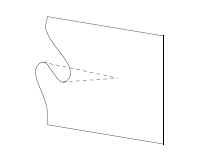Classical vs Quantum Computation (Week 18)
Posted by John Baez
Today we had our last class on Classical vs Quantum Computation for this quarter:
-
Week 18 (Mar. 15) -
2-categories from typed λ-calculi, continued.
The Church-Rosser theorem. Surface diagrams showing
the process of computation. β-reduction as a fold
catastrophe. Thom’s ideas on catastrophe theory.
Challenge: draw the surface diagram for η-reduction.
Which catastrophe does it correspond to?
Blog entry.
Supplementary reading:
- Lucien Dujardin, Catastrophe teacher: an introduction for experimentalists.
- Barnaby P. Hilken, Towards a proof theory of rewriting: the simply-typed 2λ-calculus, Theor. Comp. Sci. 170 (1996), 407–444.
- R. A. G. Seely, Weak adjointness in proof theory in Proc. Durham Conf. on Applications of Sheaves, Springer Lecture Notes in Mathematics 753, Springer, Berlin, 1979, pp. 697–701.
- R. A. G. Seely, Modeling computations: a 2-categorical framework, in Proc. Symposium on Logic in Computer Science 1987, Computer Society of the IEEE, pp. 65–71.
- C. Barry Jay and Neil Ghani, The virtues of eta-expansion, J. Functional Programming 1 (1993), 1–19.
Last week’s notes are here; next week’s notes are here.
We came pretty close to our goal of explaining how processes of computation are 2-morphisms in a 2-category. Namely, we came close to seeing how for any typed λ-calculus there’s a 2-category with
- types as objects,
- terms as morphisms,
- rewrite rules (ways of simplifying terms) as 2-morphisms.
We saw how to draw these 2-morphisms as surfaces, and we noticed an intriguing relation to René Thom’s ideas on catastrophe theory: it turned out that the process of ‘applying a function to its argument’ gives a surface with the simplest sort of catastrophe — a fold catastrophe:

We did not reach our goal of proving that the 2-category we got is a ‘cartesian closed 2-category’. In fact, we didn’t even define that concept! Nor did we get around to generalizing all this to the non-cartesian — or roughly speaking, ‘quantum’ — context.
Today’s session was a bit sad, because it’s the last one my student Mike Stay will attend. He’s the one who turned my interest in categories and computation from a hobby to something a bit more than a hobby, by coming to U.C. Riverside with a master’s in computer science and wanting to work on categories and quantum computation. Unfortunately, he couldn’t earn enough money here to support his family, so he took a job at Google, and he’s leaving town this weekend. Luckily, his skills in cryptography will now let him earn more than I do! I’m hoping he becomes a bigshot at Google and sets up a little n-category research group.
Right now we’re writing an expository paper on logic, computation, categories and Feynman diagrams, for a book Bob Coecke is editing. Google has a nice policy of letting their employees spend one day a week on projects of their own choosing. So, we’ll keep working away — but it won’t be the same. I may or may not keep the Classical vs Quantum Computation seminar going in the Spring quarter: my other students are working on other stuff!


Re: Classical vs Quantum Computation (Week 18)
I was under the impression that Whitney, not Thom, discovered the fold map, and more generally classified singularities of 2-dimensional maps (i.e. maps R2 → R2).
(I was also under the impression that since the 1980s there’s a rule against calling these things “catastrophes,” but maybe the backlash has died down enough by now.)